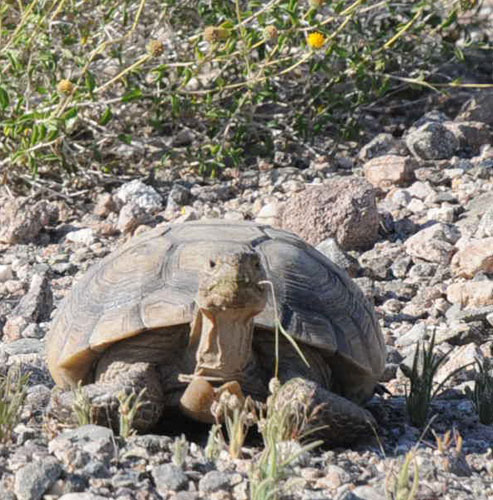 Recovering the Tortoise?
Recovering the Tortoise?
September 8, 2011 -
In March the US Fish and Wildlife Service's Desert Tortoise Recovery Office held a meeting at the Springs Preserve in Las Vegas on March 10, 2011, to discuss the new Desert Tortoise Recovery Plan that is due out. The "Desert Tortoise Management Oversight Group" was opened to a varied group of federal and state agency biologists and staff (USFWS, Bureau of Land Management, California Department of Fish and Game), employees of Mojave National Preserve, Joshua Tree National Park, Lake Mead National Recreation Area, and other park units with tortoises, as well as resource managers from Department of Defense lands such as Edwards Air Force Base. Also in attendance were private-consulting tortoise biologists, and environmental organizations, such as the Desert Tortoise Council, Western Watersheds Project, Center for Biological Diversity, The Nature Conservancy, Defenders of Wildlife, and members of Basin and Range Watch. The purpose of the meeting was for Fish and Wildlife Service staff to unveil a summary of the new Desert Tortoise Recovery Plan for 2011, and convince everyone that the plan would work. Not everyone was convinced this new direction was adequate.
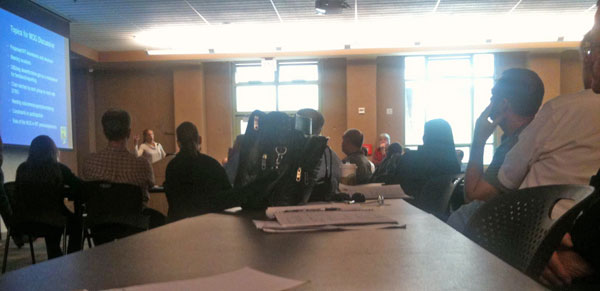
Ren Lohoefener, Regional Director of the Pacific Southwest Region of the US Fish and Wildlife Service, introduced the day by saying how his agency was grappling with how to handle the new habitat threat of large-scale renewable energy on the deserts. Since the draft Recovery Plan of 2008, renewable energy became a Presidential priority. "What do I do about it?" he asked the audience. He even suggested making the Final Recovery Plan loose-leaf in a binder so that it could be changed as new information became available. He explained he could sign the draft plan in May, make it final, and and admit we have not addressed renewable energy fully. Should we go ahead and get it out? Or hold off until the plan more fully addresses renewable energy?
Most agency people in the audience wanted the Final Recovery Plan out as soon as possible, to give guidance on siting renewable energy projects. Nevada BLM members pointed out that many renewable energy proposals were out there, the plan needed to come out. A resource manager from Edwards Air Force Base pointed out that his Head-start program (where juvenile tortoises are raised in a protected pen on their desert habitat until they are old enough to defend themselves against predators) would take 25 years to release the tortoises, and by then they might not have anything to eat due to climate changes in the desert. Other people asked that every time adaptive management was undertaken, the bar should be raised.
Center for Biological Diversity said that the older 1994 version of the Recovery Plan was actually better, a strong document which has since been weakened, and it should be updated to address renewable energy issues.
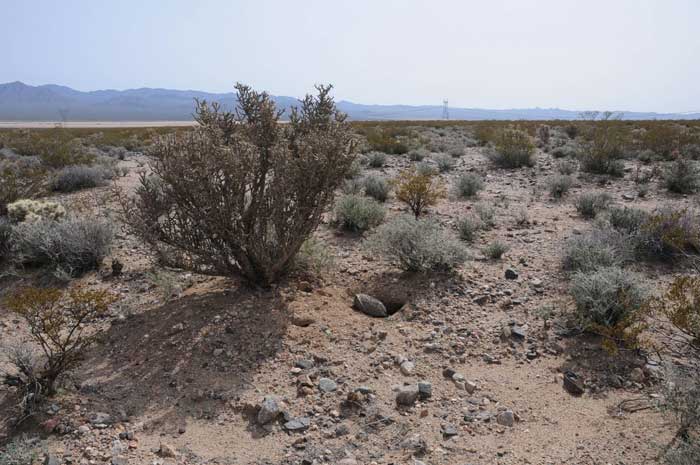
^Female Desert tortoise at her burrow in Ivanpah Valley on the Stateline Solar Project proposed site. This tortoise and many others will have to be moved to make way for large-scale renewable energy power plants.
The Revised Plan is Released
Roy Averill-Murray, Desert Tortoise Recovery Coordinator out of the US Fish and Wildlife Office in Reno, Nevada, announced that the new plan was out in August 2011. Copies can be obtained at:
Nevada Fish and Wildlife Office
1340 Financial Boulevard, Suite 234
Reno, NV 89502
(tel. 775-861-6300)
and from the DTRO website: http://www.fws.gov/nevada/desert_tortoise/.
Mr. Averill-Murray wrote in the August 25 press release: "Development of the plan has been a dynamic process that has evolved over time. Because land use change and desert tortoise recovery implementation will continue to evolve, the Final Plan is being published as a living document which will similarly evolve in the future. Reflecting the living-document concept, in the coming months we will be initiating the crafting of a supplemental chapter on renewable energy; more news on this topic will be forthcoming. In the meantime, implementation of a number of the recommended recovery actions, as articulated throughout the plan, will make progress towards reducing threats associated with energy development.
"Another reflection of the living-document concept lies in the organization of regional Recovery Implementation Teams and implementation of the spatial decision support system, as recommended in the revised plan. We soon will be organizing the Recovery Implementation Teams and look forward to working with governmental and non-governmental partners to apply a structured decision-making process to prioritize recovery implementation at regional and local scales based on the most up-to-date scientific information available. Stay tuned for more information on this topic, as well."
The original 1994 Recovery Plan was updated in 2008 and the latest 2011 update was just released. In 2002 the US Government Accountability Office of the federal government did an accounting of the effectiveness of the Recovery Plan, and found it reasonable. They recommended a more coordinated strategy to link management with research, and found that there was not enough evaluation of actions on the ground, according to Averill-Murray.
In 2004 the US Fish and Wildlife Service assessed the 1994 plan and found it strong, but in need of a more cohesive scientific program, since there were a lot of agencies covering many jurisdictions. This led to the birth of the Desert Tortoise Recovery Office, based in Reno, Nevada.
From 2005 to 2010 public and stakeholders were asked for their input on the Recovery Plan, workshops and open houses were held, comments were gathered from the public and scientific community and a review was undertaken.
Many comments stated that the revised plan was a watered down version of the 1994 plan.
Changes in the latest version of the plan include controversial adjustments of the boundaries of Recovery Units. Originally meant to follow genetic, behavioral, and geographic boundaries, these units have increasingly been changed to follow political or management boundaries. A map of the Northeastern Mojave Recovery Unit has a drastically modified boundary, moved far to the north and east of the boundary shown in the 1994 plan. The Ivanpah Valley was originally determined by genetic work to be within a unique Northeastern Mojave population of tortoises, that showed certain adaptations to the higher summer rains of this part of the desert, yet this was being changed with no apparent scientific research to back it up. The 2011 plan appears to de-emphasize genetic populations of tortoise, and downplay the former emphasis on Distinct Population Segments of a species. This goes against the trend of current biology.
Renewable energy impacts would be addressed in a future supplement to the Revised Recovery Plan, after collaboration with stakeholders, USFWS said. In other words, the problem was deferred until after the main damage is done.
Biologists Object
Some biologists wasted no time in attacking this latest iteration of the Revised Recovery Plan. In a September 1, 2011 news release, the Center for Biological Diversity put this out:
New "Recovery" Plan Weakens Desert Tortoise Safeguards
Instead of upgrading protections for the Mojave's desert tortoise, the species' new federal recovery plan makes matters worse for the ancient, threatened reptile. Until the new plan was released last Friday, the tortoise's recovery plan -- a document laying out steps and criteria for removing the species from the endangered list -- hadn't been updated since 1994. And now, while tortoise populations continue to crash, the revised plan fails to address some of the direst threats to the species, including livestock grazing, off-road vehicles, nonnative plants, climate change and energy development.
The Center for Biological Diversity has been working to save the desert tortoise since the '90s, when we filed our first appeals to stop harmful livestock grazing in tortoise habitat. So Center biologist Ileene Anderson has good authority to compare the old and new plans: "The new recovery plan only exacerbates the ongoing problem of desert tortoise recovery, which has been the failure to implement most of the science-based recommendations in the old plan. This plan simply doesn't cut it."
Revised Recovery Plan
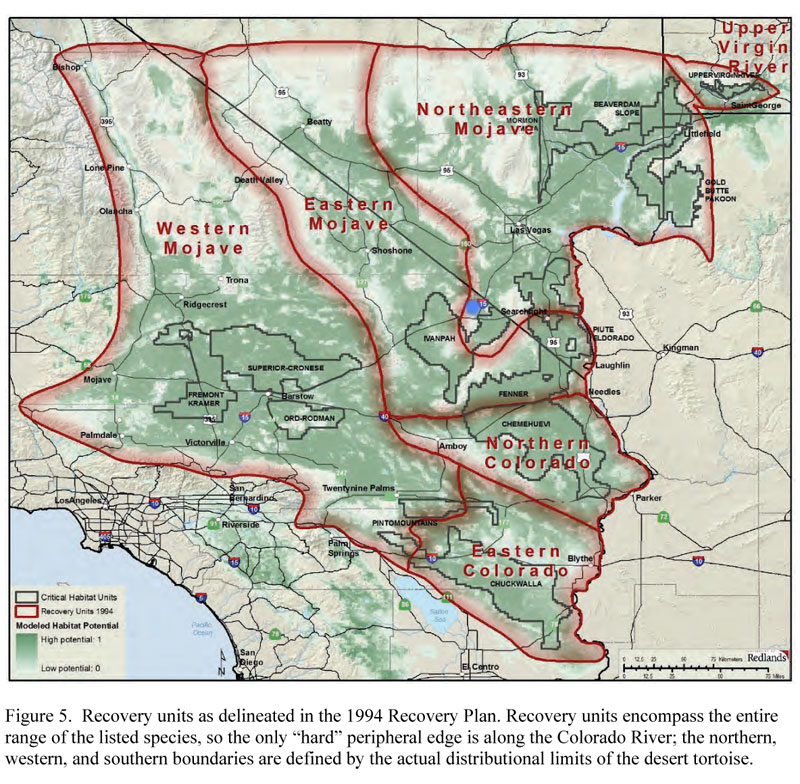
^The blue spot in the center of the map is Ivanpah Valley and the location of several large-scale solar projects, in the genetically unique Northeastern Mojave tortoise population where it just enters California.
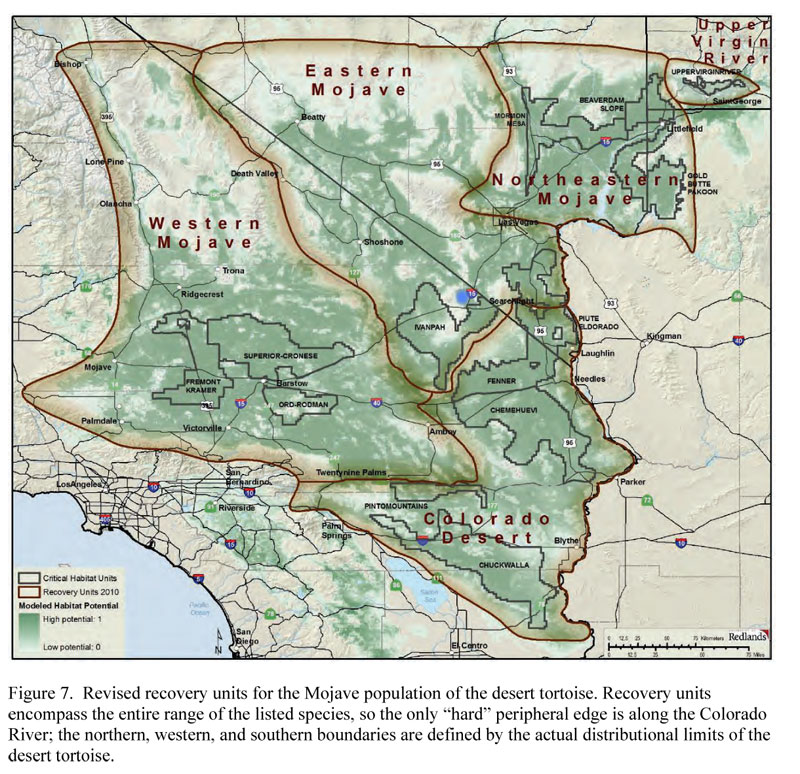
^Notice the boundary has been adjusted so that now Ivanpah Valley tortoises are no longer in the Northeastern Mojave Recovery Unit. The Northern Colorado Desert and Eastern Colorado Desert Recovery Units have been merged into a single unit. We would like to see the supporting scientific evidence for these changes. The Northeastern Mojave population is genetically the most distinctive unit of the desert tortoise in the Mojave Desert. Northeastern Mojave desert tortoises are also the most genetically distinct population of California’s desert tortoises. The range of this population is limited in California and Ivanpah Valley contains a significant portion of this range in California. When the 1994 Desert Tortoise Recovery Plan was issued, some of the highest known tortoise densities were in southern Ivanpah Valley, with 200 to 250 adults per square mile. The 2011 Revised Plan throws all this into question and confusion in one of the most contentious valleys for renewable energy development.
The 2011 Revised Recovery Plan deals with the renewable energy problem that has the potential to gobble up more tortoise habitat with this explanation for action:
In the Plan, renewable energy development is discussed in a number of locations. Discussions under “Reasons for Listing and Continuing Threats, Factor A” and “Appendix A, Section A8” identify the threat of large-scale energy development and the potential impacts to desert tortoises and their habitat. Such impacts could be realized through habitat fragmentation, isolation of desert tortoise conservation areas, and the subsequent possibility of restricted gene flow between these areas. Implementation of a number of the recommended Recovery Actions, as articulated throughout the Plan, would make progress towards reducing threats associated with energy development:
•Recovery Action 2.1, Conserve intact desert tortoise habitat -Recommends that solar project facilities be sited outside Desert Wildlife Management Areas and Areas of Critical Environmental Concern, as well as the development of a cumulative impacts assessment to identify mitigation measures for this type of activity.
•Recovery Action 2.9, Secure lands/habitat for conservation -Recommends conserving sensitive areas that would connect functional habitat or improve management capability of surrounding areas, such as inholdings within tortoise conservation areas that may be open to renewable energy development.
•Recovery Action 2.11, Connect functional habitat - Recommends connecting blocks of desert tortoise habitat, such as tortoise conservation areas, in order to maintain gene flow between populations.
•Recovery Action 4.3, Track changes in the quantity and quality of desert tortoise habitat - Recommends quantifying the loss or restoration of habitat as it relates to potential energy and other projects.
•Recovery Action 5.5, Determine the importance of corridors and physical barriers to desert tortoise distribution and gene flow - This action, in part, would determine the effects of corridors and barriers like energy development, on desert tortoise movement and recovery.
Similarly, Strategic Element 1 in the Plan’s “Recovery Strategy” specifies that activities of implementation teams at the local level will be coordinated with landscape and regional-level alternative-energy coordination efforts.
Still, the plan does not provide a single, comprehensive strategy for addressing renewable energy. To more comprehensively address this threat, the Service will soon add a renewable energy chapter to the living Plan that will act as a blueprint to allow the Service and our partners to comprehensively address renewable energy development and its relationship to desert tortoise recovery. This supplemental chapter will focus on renewable energy in a manner that could not have been envisioned when Plan revision began. The supplemental renewable energy chapter will make clear what recovery implementation will look like in light of renewable energy development and will provide specific recommendations to ensure recovery and continued habitat connectivity in light of such development. Given that, strategies for recovery implementation may be modified in the future. The chapter will reconcile recovery efforts with:
•Landscape level effects of renewable energy development on the desert tortoise. This includes identifying how such development may contribute to tortoise habitat loss and/or fragmentation.
•The role that desert tortoise translocation may play in mitigating potential impacts to desert tortoises as a result of renewable energy development.
•Other ongoing conservation strategies that have run parallel to Plan development (for example, the Desert Renewable Energy Conservation Plan, and the Bureau of Land Management’s Solar Programmatic Environmental Impact Statement) to ensure that desert tortoise recovery moves forward in a well-coordinated manner. (U.S. Fish and Wildlife Service. 2011. Revised recovery plan for the Mojave population of the desert tortoise [Gopherus agassizii]. U.S. Fish and Wildlife, pages ii-iii).
Meanwhile more tortoise high-quality habitat habitat is destroyed.
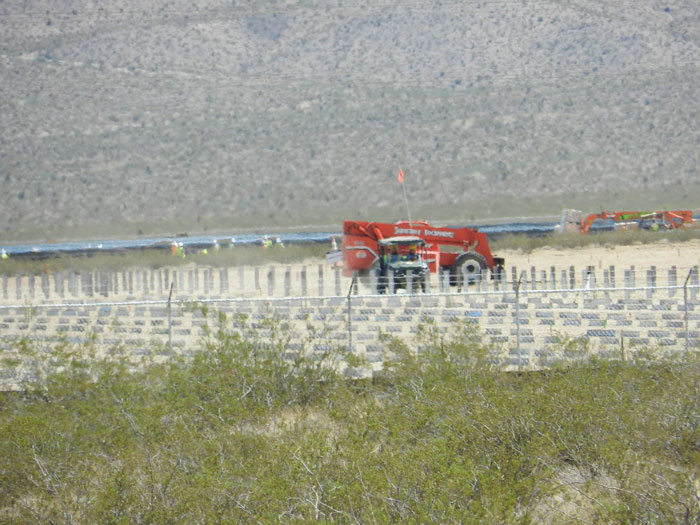
^First Solar's new Silver State South photovoltaic project under construction in Ivanpah Valley, Nevada. This was formerly tortoise habitat. Photo taken September 1, 2011.
HOME.....Tortoise Translocation.....Ivanpah Valley
